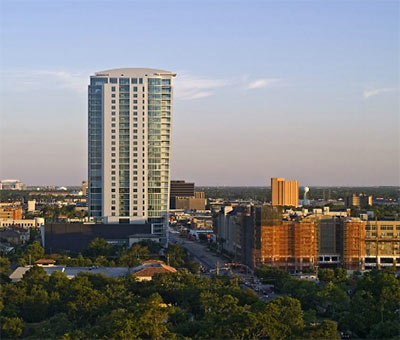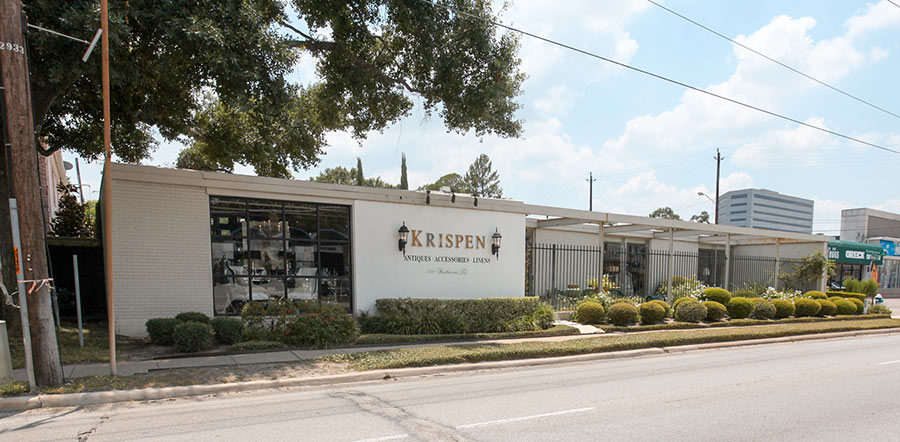
The Chronicle’s Nancy Sarnoff, after a tour of 2727 Kirby:
Developer Jerry Brown said 20 units are occupied in the 78-unit building.
The least expensive floor is priced at $575 per square foot, he said, and the average unit is about $2 million.
Maintenance fees are 65 cents per square foot.
While Brown said he’s seeing more traffic these days, there have been some snags.
I recently came across some lawsuits against the developer filed by buyers who canceled their contracts, but didn’t receive their earnest money back like they were promised.
“If they’re entitled to their money, they’ll get their money,” Brown said.
- A look inside 2727 Kirby [Prime Property]
- Previously on Swamplot: Condo Spies in the Night: Investigating Sales at 2727 Kirby, Studying Those Sales Reports for 2727 Kirby
Photo of 2727 Kirby: Ziegler Cooper





Jerry Brown (the developer) stated: “If they’re entitled to their money, they’ll get their money.”
.
Think twice about what that statement entails. There’s an implied meaning–which is what most folks read out of it–and a very specific literal meaning such as is probably lacking in key details.
.
The way I read it, Brown is promising to send refunds if and only if the proposed recipients are determined to be legally entitled to them. What is unclear is whether the arbiter of the word “entitled” is going to be Brown himself, or perhaps a judge/jury.
.
My gut says that Brown just knows how to turn a phrase and that the matter is still unsettled.
.
It’d be nice if I were wrong, though. Matters of this sort are always unpleasant.
It depends on what the contract states regarding return of earnest money. Most contracts are pretty specific and you can’t just cancel the contract because you changed your mind unless you’re willing to lose your earnest money. Most contracts have an “out” with regard to loan approval. Many buyers of course get the lender to reject the loan simply so they can withdraw from the contract. Or the lender just rejects the loan and owner occupancy is sometimes the reason why. What would be interesting to know is why they cancelled.
Ah, the wonderful world of real estate.
This is a departure from the “All but a few units are sold!” spin that was pervasive surrounding this otherwise noble project. Also, it does affirm the findings of those enterprising camera-toting day and night spies of some weeks ago.
20 units occupied does not mean or even imply that only 20 units are sold. Some owners never occupy units they purchase; some may not have been completed/decorated yet; and others may not have moved in yet to “occupy” the unit. Why all the angst about this project? It can and usually takes years to have a building this big become fully occupied. There are still units in the 20 plus year old Huntingdon that have never been built-out, much less occupied, but they were sold long ago. There are as many homes in 2727 and other big highrises as in many neighborhoods. I can’t think of any neighborhood anywhere that had every home complete, sold, and occupied immediately.
John,
How would you expect a condo developer to know how many units are physically occupied at any given time? I owned and lived in a condo for seven years. The majority of units around me were rentals with high vacancy rates, yet there was no paper trail to tie the tenant (if there was one) to the owner in the eyes of the management company or the condo board. There certainly wasn’t a mechanism to measure physical occupancy.
.
Don’t get me wrong, there were forms that condo owners were supposed to file with the management company every time someone moved in or out, but none of the owners ever bothered because it wasn’t an enforcable policy.
.
I would imagine that either the developer or Sarnoff were using the word “occupied” loosely. It applies well to other multifamily projects…just not to condos.
.
As for the angst over this project, the honest answer is that even though this was a well-conceived, competently-handled, top-tier project which should have been a huge financial success…its timing to market was poor. In truth, it’s a commercial foreclosure with a lit fuse attached to it. And that doesn’t bode well for anybody that has already purchased a unit there.
TheNiche,
I fully expect the developer to know which units are occupied in a brand new building. There is likely only one freight elevator and round the clock security. Who’s moving in or out is not a difficult thing to monitor in a high rise, infact, it’s a fairly routine security standard to know who is in the building. Garden-style condos do not compare.
I still don’t understand the angst. I doubt many people who have posted on the many forums regarding this building are buyers. Many people buy these types units as second homes (especially folks from other countries)and as investments; many corporations buy them as executive units. Most investors are absorbing losses now and moving on. This project is not unique in its difficulties with the market.
You wrote “In truth, it’s a commercial foreclosure with a lit fuse attached to it.” On what do you base such a claim? Even if true, many projects undergo foreclosure; many businesses undergo bankruptcy; it doesn’t always mean disaster or failure; just adjustment.
Alert to the would-be Ashby developers: see status of 2727 Kirby; see Mosaic towers, take a lesson . . . or not
Darby Mom,
Have much of an agenda, do you? How about the Huntingdon, 5000 Montrose, Four Leaf Towers, Inwood, Willowick, Museum Tower, etc., etc? All were built in or adjacent to high end residential and all have prospered. The Ashby issue is done. The good guys won. Move on, and perhaps vote for (and blanket the city with obnoxious yard signs) supporting zoning the next time it comes up. Otherwise, don’t be so shocked that we all, even the residents of Southampton and Broadacres have to live by the same laws and regulations as the rest of us.
John,
Is it your belief that the developer has nothing better to do with his time than track such a mundane and innocuous activity as tenant move-ins? If you’re right, then I may have to take back my comments about the project being competently-handled; it just isn’t a metric that is pertinent to his bottom line.
.
And you’re right that second home buyers and international buyers are important components of the market share for highrise condos, btw, but unless you believe that the management company is tracking such owners’ day-to-day comings and goings and passing along a report back to the developer, that has absolutely no bearing on the matter that we’re discussing.
.
As part of your response to me, you made the comment, “This project is not unique in its difficulties with the market. That’s precisely how I know that there is a lit fuse. Look at what has happened to other condo towers that have hit the market recently. Then consider that mortgage markets for condos and jumbo loans are still poor, that interest rates are rising, that the value of residential housing at comparable price points is declining, and that prospective buyers’ capability to fund their purchases is severely diminished at present. This project is firmly lodged within The Suck.
.
However…since apparently you do not consider financial ramifications relevant to your definition of what constitutes a project’s “success” or “failure”, just what metric are you using?
TheNiche,
I will only reply to one part of your last comments because we are so far apart on our understanding of these issues that this could go on for days.
You wrote, “Is it your belief that the developer has nothing better to do with his time than track such a mundane and innocuous activity as tenant move-ins? If you’re right, then I may have to take back my comments about the project being competently-handled; it just isn’t a metric that is pertinent to his bottom line.”
–
It’s not my belief; it’s my knowledge and experience. I’ve been involved in design/construction/development for 20 yrs. In any multi-family development, especially in highrises, the developer also manages the building and common areas, at least until it is 51% sold and an HOA made up of homeowners can take over that management.
–
Some developers hold on to control until the property is 75% or even 100% sold. Many developers operate management companies as a side business to continue to operate the properties for the HOAs after the homeowners take over official control – for considerable fees. Knowing who is occupying units is part of the responsibility of whomever is managing the building.
–
If for nothing more than safety considerations, the manager of the building MUST know which units are occupied. If there is a fire in the building, especially in a highrise, one of the first things the Fire Department will need to know is which units are occupied and which ones are not. Lives could be at stake. I’m not sure why you find this relatively simple and common, and required element of building management to be “a mundane and innocuous activity”. Or who, if not the developer of a new property do you think is managing the building?
–
Any owner of a luxury highrise building will tell you that they expect top-notch security and yes, they expect that security to be fully aware of who is coming into and going from the building. This is not atypical. I’m guessing you’ve never lived in a full-service high rise?
My perspective is that of someone who has actually worked in the headquarters offices of a multifamily developer that builds and manages both apartments and condos. We hired people like you.
.
There is very clearly a need for bare-minimum recordkeeping and security procedures, but the only thing that concerns the developer is that the **process** is adequate to mitigate certain potential legal and casualty liabilities. It’s just a risk management tool to him. Subordinate personnel are tasked with the mundane details, but unless those particulars become materially relevant to the bottom line (for instance as a consequence of a fire, as you suggested)…the owner cannot be bothered with them.
.
Move-ins will never–NEVER!–get reported in a staff meeting. Sales and sales prospects are reported on because that’s the organization’s bread and butter. It is what pays the mortgage.
The nastiness of the people defending this project kind of makes me want to see it fail.
The nastiness of the people defending this project kind of makes me want to see it fail.
And what are they defending it from?
No one is attacking this project. They are just stating the facts about it. TheNiche said that he believes the project is a well-conceived, competently-handled, top-tier project which should have been a huge financial success. It is not the fault of the developers or the designers of this project that it is having problems. It is the timing. If your trying to defend this project then you must be defending it against the laws of economics because no one else is attacking it.
Does anyone actually know whether 2727 Kirby’s developer is having any sort of financial difficulty?
I, for one, wish the folks who built this building nothing but the best.
This topic has become stale. No one knows anything, and all the guesses and opinions have become repetitive and boring. I simply wish the developers who built such a great project well, and those who are buying in it the best.
This may well be history repeating itself…
.
The Huntingdon was built at the top of the market in the early/mid eighties, went bust, was taken over by the RTC, eventually purchased out of the RTC scrap bin in the mid 90’s, and the units were eventually all sold by 1999 or so.
.
The top of Houston’s 1980’s housing bubble was characterized by a rash of high-rise condo construction, just like today. The developers (and investors) of those projects suffered due to their unlucky timing, as appears to be happening with the current crop of high rise condos today. It is a sad situation.
Uh oh. The down market cat is out of the bag. Its a beautiful,but virtually empty building. It’ll take years to sell out.
Has there been any newer investigations of 2727 Kirby?
Is there any more news on the law suits pending against 2727 Kirby? The building still seems quite empty and with law suits pending the future of this building seems to be slightly rocky. If the building goes under what happens to the people to have already purchased condos and to those who have contracts but haven’t closed on their condos?
I’m unfamiliar with the legal situation as it presently stands, but if there is a bankruptcy or mass foreclosure then the unsold units are taken by the trustee or the bank (respectively) and are marketed for sale as a deeply discounted package to an investor that is willing to take the time and effort to resale them to consumers. If the HOA hasn’t kicked in yet because not enough units have sold, then there is a possibility that services will be cut back, but that’s nothing that an active HOA couldn’t restore at a later date.
.
Someone trying to purchase a unit might have their purchase delayed slightly while this stuff gets worked out. But when the units come back to the market, it is entirely possible that they’ll be at a lower price point because the seller’s basis will be so much lower than the developer’s had been. This circumstance could hurt individual owners trying to resell their unit over the next several years.
.
Another thing that could hurt owners is if there aren’t restrictions on an owner renting units in bulk. A large rental population would not be desirable, but that may be the path taken by an investor.